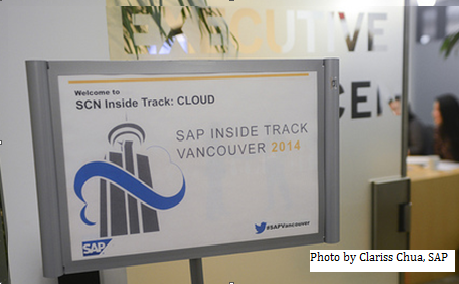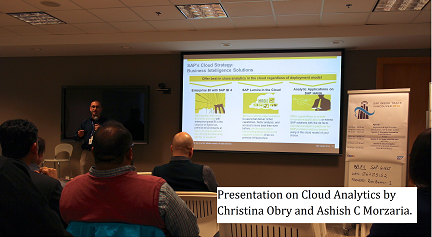
- SAP Community
- Products and Technology
- Technology
- Technology Blogs by SAP
- Riding the SAP Cloud for Future Business Success
- Subscribe to RSS Feed
- Mark as New
- Mark as Read
- Bookmark
- Subscribe
- Printer Friendly Page
- Report Inappropriate Content
I am a Co-Op from UBC (http://www.ubc.ca/), studying math and economics, and I am currently on the SAP Global Licensing team. On March 3rd, I had the opportunity to join the 5th SAP Inside Track event in Vancouver, Canada. This year’s theme was SAP Cloud. The event consisted of three sessio ns:
ns:
- Cloud Computing and Business Gets Social
- Leverage powerful work patterns and go social with SAP Jam, which covered the integration of SAP Jam in the cloud with SAP CRM on-premise
- Cloud Analytics, which covered SAP HANA Enterprise Cloud, SAP HANA Cloud Platform, and BI Solution such as SAP Lumira Cloud
I think that the event is a great way for businesses that are using or are considering SAP products to run their businesses more efficiently to learn about SAP Cloud and SAP products. My expectations were met fully by the insightful presentations from which I learned about SAP’s information technology more in-depth and the SAP partners and customers whom I got to meet.
How will Cloud Computing help make SAP customers successful in the market and world economy?
In this blog, I would like to share what I had learned from the 3 sessions and how Cloud can help bring success to SAP customers in the market and the world economy.
First, what is Cloud Computing?
SAP Cloud Computing is on-demand delivery through the Internet of IT resources, such as servers, applications, storage, and it is based on pay-as-you-go pricing. “Cloud Computing is a style of computing, not a technology” stated Brian Clendenin (Speaker from SAP SuccessFactors).
Benefits of Cloud:
Cloud has characteristics that make it the future of information technology. It is scalable and elastic, shared, and metered by use. End-users can add or remove resources as needed from the Cloud. In the process, companies do not need to be concerned about investing in expensive servers; they would avoid large sunk costs. Companies do not need to think about storage space when operating on Cloud. Cloud services share resources to build economies of scale, and companies pay for Cloud based on how much memory the company uses on Cloud for operating its business. Businesses are able to select which segments of their industry are on Cloud.
Cloud Computing improves efficiency and reduces IT costs. As a result, firms are able to focus more on innovation.
The SAP Cloud Application Portfolio consists of Core HR Cloud, Recruiting Cloud, HR Analytics Cloud, Customer Cloud, SAP Cloud for Financials, Spend Analytics Cloud, etc. Firms can select which one to use for their business, providing the firms with flexibility. “The strategic planning assumption is that by 2016, 75% of business applications will be put on Cloud,” stated Brian Clendenin.
Cloud makes it easier for new businesses to enter the market. In most situations, a new company will not have the money to purchase servers for on-premise infrastructure or metro-capital companies will not loan the new company money. Therefore, it is best for this new company to go on Cloud. For the companies that have been using on-premise infrastructure, it would be best to implement the hybrid model (partly on-premise and partly on cloud). It is predicted that hybrid models will dominate for the next 10 years.
Benefits of SAP Jam in the Cloud:
SAP Jam is a social collaboration platform; it is in the Cloud, integrated with SAP CRM on-premise. SAP Jam allows Sales organization to win sales opportunities, manage key customer accounts, shorten sales cycles, collaborate within a group, and increase ROI (or Return on Investment). SAP Jam in the Cloud is going social with SAP Jam Cloud for Financials, SAP Jam Cloud Sales, etc. It provides secure social collaboration and protects corporate data. As an enterprise social network solution, SAP Jam helps businesses communicate and strategize with partners, vendors, and customers, improving companies’ problem solving and decision making. It pulls live data from the CRM, allowing decision making and business progress to happen faster, and it reduces training costs. SAP Jam also deploys very rapidly.

Benefits of SAP Lumira on Cloud:
Having used Lumira for analyzing my team’s datasets, I would definitely agree that SAP Lumira is a great data visualization tool that provides a wide range of tables and charts, the ability to carry out calculations on large datasets, and the capability to create a storyboard. Now, SAP Lumira is provided on Cloud. SAP Lumira on Cloud deploys the application and analytics to customers very quickly.
Did you know that SAP (or Businessobjects) has been delivering Cloud solutions to its customers for over 10 years? I did not realize this fact until Ashish Morzaria mentioned it in the Cloud Analytics presentation.
- SAP Managed Tags:
- SAP Inside Track,
- SAP Lumira,
- SAP ERP,
- SAP HANA,
- Cloud,
- Virtualization
- ASUG
- bc chapter
- cit van
- Cloud
- cloud analytics
- cloud computing
- cloud on-demand and saas
- community day
- community event
- community events
- Events
- hana cloud platform
- hana enterprise cloud
- inside track
- return on investment
- sap analytics
- SAP Businessobjects BI Ondemand
- sap cloud for customers
- sap cloud for finance
- sap cloud for financials
- sap cloud for sales
- sap hana
- Sap inside track
- SAP Jam
- SAP Lumira
- sap lumira cloud
- sapevents
- SAPInsideTrack
- sitvan
- User Groups
- vancouver
- Virtualization
You must be a registered user to add a comment. If you've already registered, sign in. Otherwise, register and sign in.
-
ABAP CDS Views - CDC (Change Data Capture)
2 -
AI
1 -
Analyze Workload Data
1 -
BTP
1 -
Business and IT Integration
2 -
Business application stu
1 -
Business Technology Platform
1 -
Business Trends
1,661 -
Business Trends
87 -
CAP
1 -
cf
1 -
Cloud Foundry
1 -
Confluent
1 -
Customer COE Basics and Fundamentals
1 -
Customer COE Latest and Greatest
3 -
Customer Data Browser app
1 -
Data Analysis Tool
1 -
data migration
1 -
data transfer
1 -
Datasphere
2 -
Event Information
1,400 -
Event Information
64 -
Expert
1 -
Expert Insights
178 -
Expert Insights
273 -
General
1 -
Google cloud
1 -
Google Next'24
1 -
Kafka
1 -
Life at SAP
784 -
Life at SAP
11 -
Migrate your Data App
1 -
MTA
1 -
Network Performance Analysis
1 -
NodeJS
1 -
PDF
1 -
POC
1 -
Product Updates
4,577 -
Product Updates
324 -
Replication Flow
1 -
RisewithSAP
1 -
SAP BTP
1 -
SAP BTP Cloud Foundry
1 -
SAP Cloud ALM
1 -
SAP Cloud Application Programming Model
1 -
SAP Datasphere
2 -
SAP S4HANA Cloud
1 -
SAP S4HANA Migration Cockpit
1 -
Technology Updates
6,886 -
Technology Updates
402 -
Workload Fluctuations
1
- Fiori Elements App - With Intent Based Navigation doesn't get rendered in Technology Q&A
- Capture Your Own Workload Statistics in the ABAP Environment in the Cloud in Technology Blogs by SAP
- Empowering Retail Business with a Seamless Data Migration to SAP S/4HANA in Technology Blogs by Members
- 10+ ways to reshape your SAP landscape with SAP Business Technology Platform - Blog 7 in Technology Blogs by SAP
- 10+ ways to reshape your SAP landscape with SAP BTP - Blog 4 Interview in Technology Blogs by SAP
| User | Count |
|---|---|
| 12 | |
| 9 | |
| 8 | |
| 7 | |
| 7 | |
| 6 | |
| 6 | |
| 6 | |
| 6 | |
| 4 |